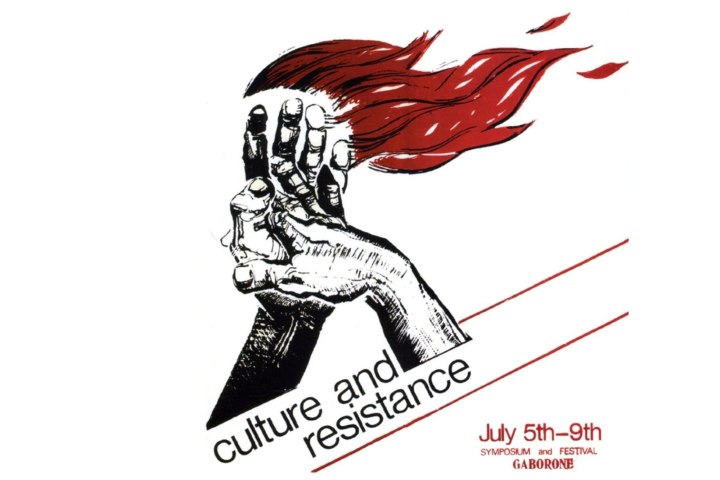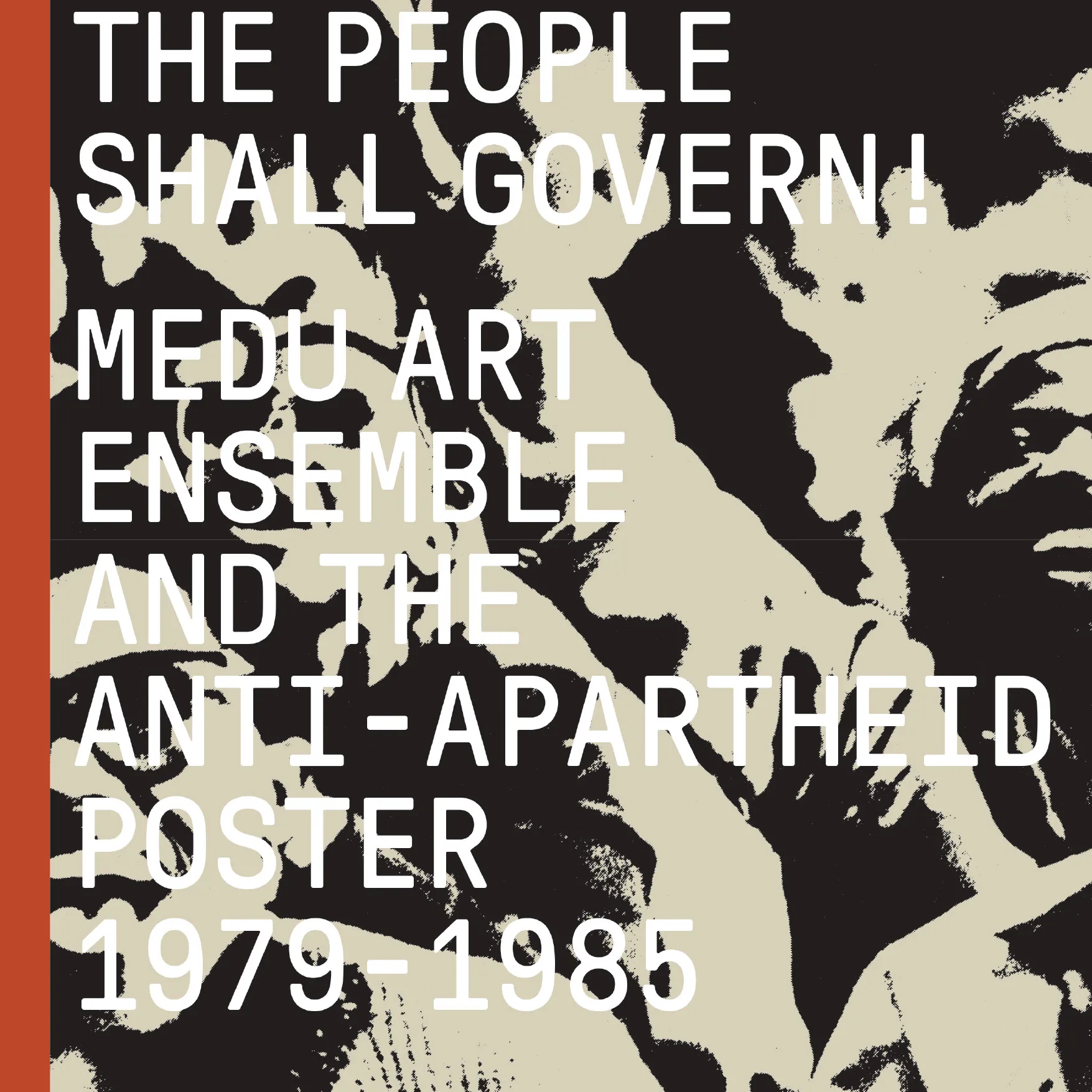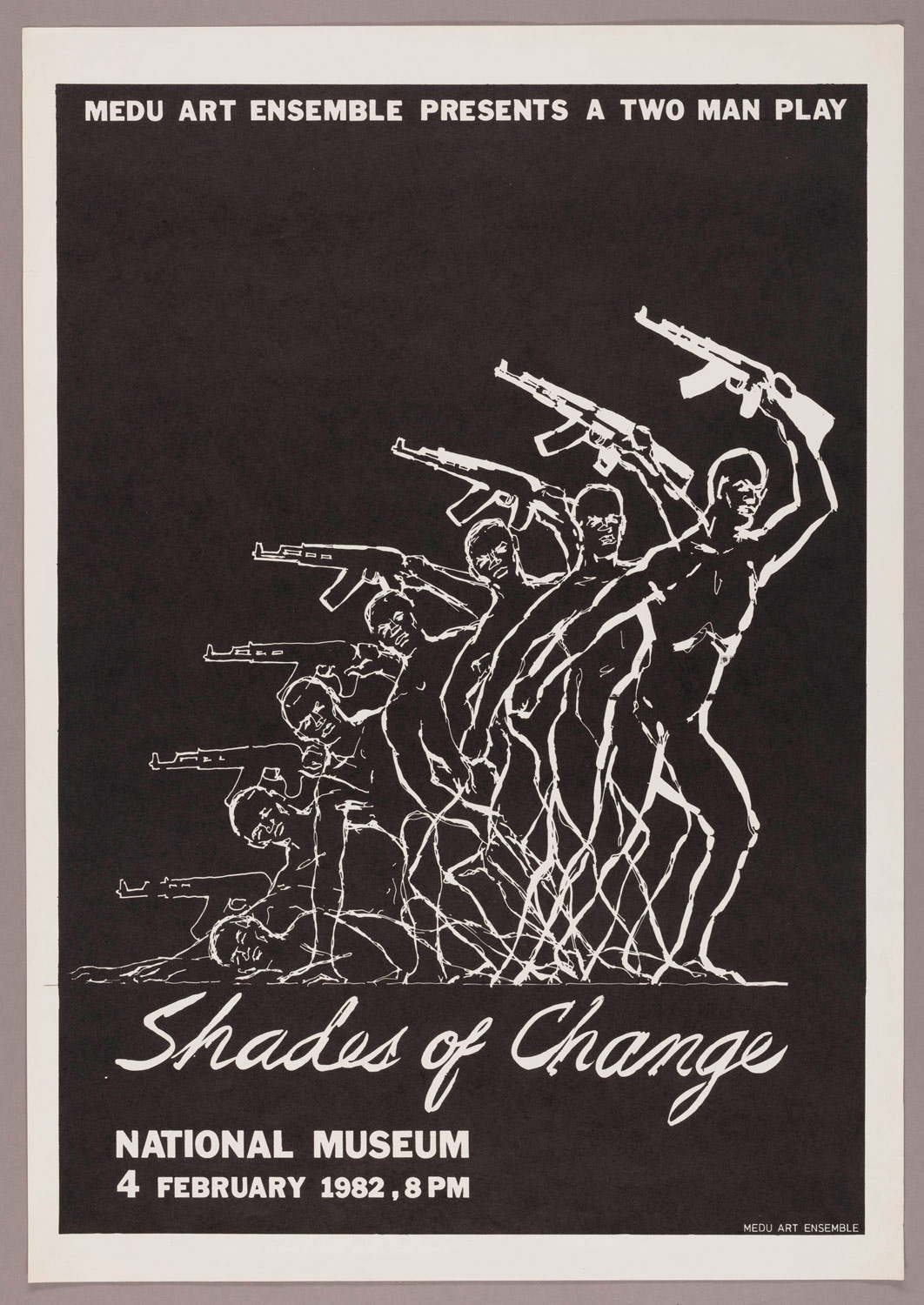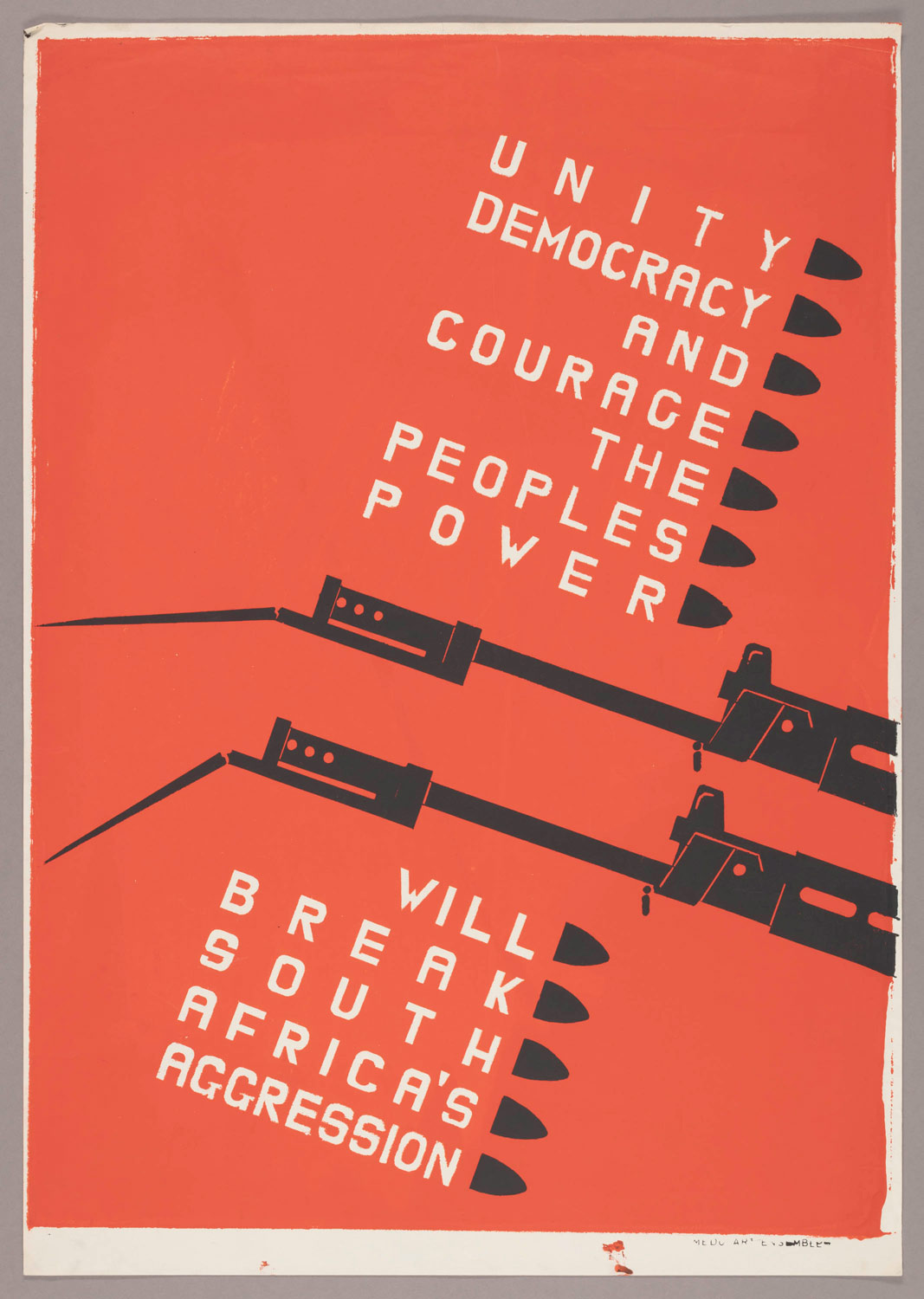NEW FRAME
The anti-apartheid posters of Medu

The names of those who created the posters have only recently been revealed, such was the power of the threat their collective artwork held for the apartheid authorities.
This story was first published on New Frame.
Poet laureate of South Africa and founding member of the Medu Art Ensemble, Mongane Wally Serote, situates the origins of the ensemble by describing the context that gave rise to it: “Like the European colonial rulers, the architects of apartheid held a gun in one hand and a Bible in the other as they targeted and attempted to destroy the culture of indigenous Africans and all freedom-loving people. In opposition to such divisive tactics, Medu Art Ensemble originated in forms of unity and solidarity.”
In SeSotho, medu means roots. It’s a fitting visual image for the collective that operated from Gaborone, Botswana, between 1979 and 1985 – and particularly for the underground dissemination of screen-printed and offset lithography posters for which Medu is best known. It is also a fitting description of Medu’s organically evolved organisational structure. The collective was comprised of more than 60 visual artists, performers and writers, mainly South African exiles but with members from Botswana, Canada, Cuba, Sweden and North America.
The revolutionary collective was divided into six units: Publications and Research, Film, Photography, Theatre, Music and Graphics. Each unit had a life of its own, meeting to work and deciding on its own leadership structures and pace. Members often belonged to more than one unit, which similarly worked together. Medu members adopted the appellation “cultural workers”, choosing not to identify as artists because of the shared belief that as culture was of the people, it could not and should not be confined to the exclusionary art world of the apartheid era.
The book The People Shall Govern! Medu Art Ensemble and the Anti-Apartheid Poster, 1979-1985 was released late last year. It was preceded by an exhibition of the same name at the Art Institute of Chicago, curated by Antawan I Byrd and Felicia Mings. The book and the exhibition originated from the 2018 gift to the museum of an outstanding set of Medu posters from an anonymous donor who asked to be recognised only as the Artworkers Retirement Society.

13 October 2020: The cover of The People Shall Govern! (Image courtesy of the Art Institute of Chicago)
A beautifully designed catalogue with a gorgeous silk-screened cover, The People Shall Govern! features nearly all the surviving posters that Medu created between 1979 and 1985. They make up more than 80 examples of an estimated 100 designs that Medu produced in Botswana and smuggled into South Africa, which were regularly confiscated or torn down on sight.
The posters are accompanied by informed and interesting insights from Byrd and Mings into the conceptual framework of Medu’s working practice, as well as essays from founding Medu member Serote, curator Khwezi Gule, academic Ashraf Jamal and art collector Warren Siebrits. In addition to Serote’s account of the beginnings of Medu and the collective’s formative affiliations with the ANC, the voices of Medu members feature as quotes between the posters.
The majority of posters were simply signed Medu, which Byrd and Felicia Ming explain was “an affirmation of the collectivist spirit central to the work’s conception and production”.

27 April 2019: Installation view of the exhibition. (Image courtesy of the Art Institute of Chicago)
Motivated by a belief in collaborative debate and production, the collective promoted the content of the posters over the names of the designers. More than just an ideological preference, the Medu inscription protected members and their families from targeted acts of retribution by the notoriously vindictive apartheid authorities. It is therefore sobering to read when Byrd and Mings write that today, more than two decades after the collapse of the apartheid state, it is finally safe to identify participants and where possible give credit to individual designers. This is important. The work of Medu is relatively recent history that is still difficult for many to reckon with, especially when considering the collective’s tragically untimely dissolution.
The South African Defence Force (SADF) Special Forces launched a cross-border attack on ANC targets in Gaborone on 14 June 1985. It resulted in the deaths of 12 men and women, including a six-year-old child: Ahmed Mohammed Geer, Michael Hamlyn, Gladys Kesupile, Eugenia Kakale Kobole, Duke Machobane, Joseph Malaza, Peter Mafoka, George Phahle, Thamsanga “Thami” Mnyele, Dick Mtsweni, Lindiwe Phahle and Basi Zondi. Medu ceased to exist after the attack.
The People Shall Govern! is more than an art book, it is also a window into a strangely surreal slice of time that ended tragically, an opportunity to think with and through a body of work that reflects that time, in terms of the great forces of history that we carry within us as frames of reference, identity and aspiration. Most importantly, perhaps, it offers a way to think about what it means to be a cultural worker.

Circa 1979: The Constellation of States by the Medu Art Ensemble. (Photograph by the Art Institute of Chicago, gift of the Artworkers Retirement Society © Medu Art Ensemble)
Medu’s role in anti-apartheid poster history
This is neither the first book about Medu nor about anti-apartheid posters. To date, the most comprehensive publication on Medu’s work across all six units is the Thami Mnyele + Medu Art Ensemble Retrospective exhibition catalogue by Clive Kellner and Sergio-Albio Gonzáles. Also the book Images of Defiance: South African Resistance Posters of the 1980s by The Posterbook Collective.
In the foreword to the latter, Nelson Rolihlahla Mandela encourages care when commenting on posters produced by the democratic movement in the 1980s: “This is our collective work, of which I am naturally very proud. It would be very easy to exaggerate, to overstate my own feelings about them. Having said that, I nevertheless acknowledge feelings of great pride, that in spite of the difficulties our people have had to face, they were able to produce such work.”

Circa 1981: …and the people vote for Nelson Mandela by Judy A Seidman as the Medu Art Ensemble. (Photograph by the Art Institute of Chicago, gift of the Artworkers Retirement Society © Medu Art Ensemble)
Images of Defiance traces the history of posters in South Africa to the 20th century, when they were used mainly for commercial advertising and portrait of the candidate-type political propaganda for whites-only elections. The extent to which posters were employed in the 1950s anti-apartheid struggles is unclear, but it seems likely that banners and leaflets were more widespread mediums. The use of graphics for mass public protest declined sharply in the 1960s, after the suppression of the ANC. And while the rise of trade unions emerged as a major source of power in the 1970s, posters were only employed widely as a protest medium towards the end of that decade.
Posters featured prominently in the student uprisings of June 1976, but these were mainly individually made. Soon after, many designs began circulating to commemorate the death in detention of Black consciousness leader Steve Biko in 1977. Exiles and sympathisers around the world were producing anti-apartheid posters, but getting them into the country was tricky.

Circa 1983: The People Shall Defeat Aggression by Thamsanqa Mnyele and Judy A Seidman as the Medu Art Ensemble. (Photograph by the Art Institute of Chicago, gift of the Artworkers Retirement Society © Medu Art Ensemble)
In essence, the real era of poster production in South Africa began in the 1980s, with Medu at the helm.
Medu encouraged silk-screening as a communication technique for the mass movement because it required no electricity and relatively little equipment or capital outlay, and the skill was easily transferable.
Medu organised its first major event, the Culture and Resistance Conference, in July 1982 and droves of cultural workers from South Africa attended. Following its success, the apartheid government banned Medu posters within days of publication, and distribution crumbled as people risked years in jail for smuggling posters across the border.
But the seed had been sown and soon silk-screen training workshops took off around the country, facilitated by organisations such as the Screen Training Project in Johannesburg and the Community Arts Project in Cape Town, both of which were established a year after the conference.
The publication
The People Shall Govern! goes beyond historical accounts to engage critically with the aesthetics of the collective’s poster production. Byrd’s essay, for instance, shows how Medu gravitated towards cut-and-paste montage techniques to dissect apartheid’s historical foundations and everyday terror, mirroring notable poster precedence in the Bolshevik revolution, and the rise of fascism and National Socialism in 1920s and 1930s Europe.
The publication is, however, careful to avoid sidelining the politics of Medu’s poster production in favour of their visual appeal. Mings’ essay analyses posters that illustrate “Gaborone’s unique position, at once regional and international, in the international anti-apartheid network, demonstrating Botswana’s influence on graphic advocacy”.

Circa 1982: The People Shall Govern! by Judy A Seidman as the Medu Art Ensemble (Photograph by the Art Institute of Chicago, gift of Artworkers Retirement Society © Medu Art Ensemble)
Gule contextualises Medu in the heightened mood of militarism following the 1976 Soweto uprising and conceptions of “art as weapon”. Conversely, Jamal questions the efficacy of interpreting Medu solely as a reaction to apartheid, saying instead that the legacy of the collective lies in its humanism and generative conception of community. Finally, Siebrits reflects on his experience collecting Medu posters.
These are interesting contributions, but the glaring absence of female contributors is questionable. Judy Seidman and Teresa Devant are the only female Medu members quoted. While this could be a result of remaining Medu members being as difficult to track down as the posters they produced, the role of women in the anti-apartheid struggle is well documented and there is sufficient critical attention to questions of (in)visibility of Black women in liberation movements for this gap to be disappointing. When asked about the choice of contributors, Byrd and Mings explained that they wanted contributions from those with existing insights into Medu’s work, such as Gule, who worked on the Thami Mnyele + Medu Art Ensemble Retrospective in 2009.
Siebrits’ reflections on the origin of his interest in Medu posters is the most personal in the publication. He details two years of compulsory SADF active service starting in 1987, during which one of the main tasks of his unit was to destroy “subversive enemy propaganda posters”, resulting in his desire to assemble a comprehensive collection of these works.
In an interview, he explained that after years of collecting these posters, he eventually sold his entire collection to the anonymous donor who then gave them to the Art Institute. This is not the only Medu collection. Judy Seidman has an extensive private collection and Freedom Park has a large, publicly accessible collection that is available digitally at the International Digital Ephemera Project.
According to Siebrits, the price of an average anti-apartheid poster is between R1 000 and R4 000, while popular Medu poster designs – when they can be found – start at around R15 000. But the poster trade circuit is a tight network of book and art collectors, making it difficult to process the marketisation of these works from Medu, given its origins and aims.
While recognising the aesthetic appeal of posters, their valuation over time and appreciating global attention to this, seeing this political heritage subjected to the obscure market logics and supply chains of collectors and international museums is difficult to swallow.
This publication is an exhibition catalogue, not a people’s history. But Byrd and Mings have made a sincere effort to not only catalogue the posters and members (a biographical index is included), but also to “people” the publication with the voices of Medu members. Readers may desire to get past the beautiful design of the posters and the weight of the context in which they were produced, to view the many photos included in the publication and learn more about the personalities and lives of those involved.
The cultural workers
In an interview, Basil Jones explained that for him and Adrian Kohler, who were active in Medu between 1979 and 1981, it was incredible to be accepted in Gaborone where “the struggle was everything: not who you were or where you came from. For two queer boys arriving in Gaborone and being ‘out’ and living together, it was wild to be with such intense black artists.”
He observed that a less-discussed aspect of the Medu Art Ensemble has been the influence and success of the members, many of whom have since pursued illustrious careers. Jones and Kohler left Botswana to found the award-winning Handspring Puppet Company.
Jones also echoed Jamal’s statement that while the magnetic forcefield of Medu was the struggle against apartheid, which necessarily shaped the aesthetics of members, it is important not to forget that the art of Medu is more than the posters: “The vortex of the period pulled people out of shape, since so much happening was literally about life and death. The same thing can be seen throughout the international left where artists made things for movements, not themselves.”

Circa 1982: Shades of Change by Sergio-Albio Gonzalez as the Medu Art Ensemble. (Photograph by the Art Institute of Chicago, gift of the Artworkers Retirement Society © Medu Art Ensemble)
But for some, compartmentalising was a way to shape meaningful lives in a time of senseless violence. Baleka Mbete, who was active in Medu between 1981 and 1985, remembers it as a space to be fully human despite the cloud of danger. Medu was an opportunity to be a multilayered individual, something denied by apartheid oppression. In 1983, Mbete became the chairperson of Medu and a lead singer for the band Shakawe.
She paints a picture of bustle, with underground political activities such as facilitating military training for the droves of youth entering and exiting South Africa jostling with the daily labours of participating in various branches of the ANC and Medu structures. Simultaneously, she describes herself during this time as “an artist that had to sing every day while raising my children, dashing around at night looking for safe spaces to sleep”. Juggling political activities, family responsibilities and creative passions was surely not easy but according to Mbete, “part of being a cultural worker, is structuring these priorities”.
At the Culture and Resistance Conference in 1982, Thami Mnyele posed a question still pertinent today: “What does true political consciousness mean for the artist in my country?” He declared that the role of the artist was “to learn, to teach others, and to ceaselessly search for ways and means for achieving freedom.”
It is tempting to think of Medu as a highly organised collective of accomplished professionals. But Mbete explains that Medu was full of very young people who had never had the opportunity to get the type of exposure that members such as Hugh Masekela, Caiphus Semenya and Keorapetse William Kgositsile had in the United States and around the world. Medu offered training for young artists or writers, skills that they would never have been able to get in South Africa. “You know the actress Connie Ferguson? She was a Medu member too, a very young one. We were just human beings, doing what we liked to do,” Mbete says.
“The first time Jonas Gwangwa came to my house to hear me sing, he watched and said, ‘You sing like you are in a school choir with that uptight voice.’” She mimics raising her shoulders, stiffly, while saying this. “As time went on, he taught me ways of relaxing, not just my voice but my expression, too. Medu was a wonderful space for those that had been in exile much further away. Jonas, Bra Willie, Wally and Bra Hugh had already spent nearly two decades in the US and the UK by then. We were in this tiny Gaborone, and I can’t describe how good that time was in relative terms. Still in exile, unable to go home, but able to interact with each other and receive visits and most of all, to be so close to home, feeling the energy of South Africa.”

27 April 2019: Part of the installation exhibited at the Art Institute of Chicago. (Image courtesy of the Art Institute of Chicago)
The account sits well with Serote’s reminder that “while speaking of the anti-apartheid struggle, it is important to note that South Africans have lived in the country of their dream, no matter how imperfect, for more than two decades”. And at the same time, to remember that this was not without cost and that these posters are more than just art, arresting though they be.
Mbete reveals that the last time she saw Mnyele was the night he was killed. “I told him, ‘Thami, I hope you are no longer sleeping in this house.’ There was a red alert so none of us were sleeping in our houses, moving around to stay safe. He had gone home because sometimes you get tired and run out of ideas about where to go.

Circa 1983: Unity, Democracy and Courage by Thamsanqa Mnyele as the Medu Art Ensemble. (Photograph by the Art Institute of Chicago, gift of the Artworkers Retirement Society © Medu Art Ensemble)
“His body was found outside of his house but, interestingly, those apartheid agents that entered his house that night attacked a trunk full of artworks and posters, they riddled it with bullets. That’s how much they felt threatened by the work that Medu was doing in Gaborone at that time. This is why it is important for Medu not to get buried in time.” DM/ML

















 Become an Insider
Become an Insider
Comments - Please login in order to comment.